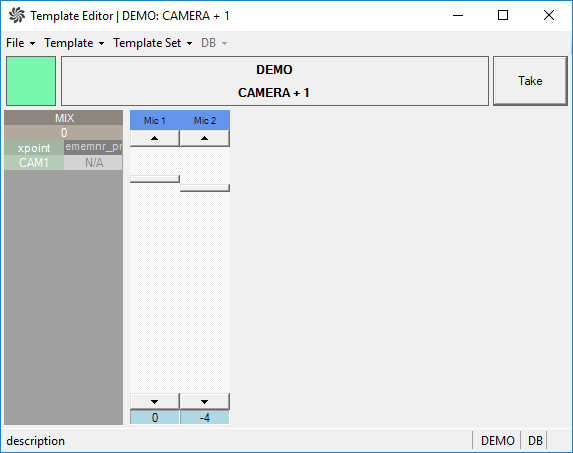
Viz Mosart Administrator Guide
Version 5.6 | Published July 22, 2024 ©
Overview
Behind each operation, as displayed on the timeline in Viz Mosart's Rundown view, is a Viz Mosart template.
A Viz Mosart template is the key element of controlling external devices and events handled by Viz Mosart. A template can send simultaneous control commands to multiple studio devices.
Typically, the actions defined on a template are either:
-
Automatic
Either invoked from another template or at a given time as part of the rundown -
Preconfigured
Configured in the newsroom control system (NRCS or NCS) as part of a rundown, and then manually executed by the Viz Mosart operator -
Manual
The operator initiates the template-driven operation, usually from a keyboard shortcut or touch panel.
Some essential template concepts are introduced below:
Template Sets
Templates are organized in template sets. Typically, there will be a template set for each show/program. As Viz Mosart runs, one template set will be current, meaning templates that will be executed during the show are drawn from this set.
An alternative set can be selected as the new current set, see Overview below. The templates that comprise a show can be arranged in two ways:
Standalone
Traditionally, Viz Mosart template sets are treated individually, with no connection to each other.
For example, a template set is created for each show or program. This is usually combined with automatically selecting the template set through the associated NRCS rundown. In addition, startup commands for preparing the studio (lights, sound etc.) for running the show are included in the template set.
When creating a template set for a new program, it is based upon a copy of an existing template set, with small adjustments according to the functionality needed by the program.
When this new template set is created (by copying an existing set), a copy of all templates is made, and no references are made between the original and copied templates. Each template set is classified as ‘standalone’.
Disadvantages with this approach:
-
Many duplicates are created. Normally only a few of the templates in the set need to be adjusted for meeting the needs of a new program.
-
With an ever-growing bank of templates being created for each new show, the amount of stored templates in Viz Mosart can exceed system norms. This results in long response times when saving templates and increases the memory footprint of both the Mosart Server and Viz Mosart client workstations.
-
Maintenance of templates becomes cumbersome and error prone. When a change is made in a template that is common for all template sets, the same change has to be applied individually to every template set. This is a time consuming task across numerous template sets.
Hierarchical
An alternative approach to Standalone is hierarchical template sets. This method also enables a new template set to be created, based on the logic of an existing template set. However, to begin with, no templates are copied from the existing template set.
Only when a change is made to an existing template, or when a new template created, is a template created and stored in the new template set.
The hierarchical approach can be adopted with all existing (standalone) template sets, to optimize machine capacity and introduce a more efficient workflow.
Referring to the background discussion in Overview above, when you copy a template set, it is more efficient to use a hierarchical approach. These operations are usually performed by a system administrator, as outlined in Overview below.
Direct Takes
In addition to standard show-related template sets, there is a special template set called Directtakes.
Unlike standard templates, templates in this set are not intended to be executed as part of the rundown.
Instead, they are usually manually executed during a running show immediately in an ad-hoc fashion.
Often a unique numeric value is assigned to each direct take. The operator enters executes the direct take template by entering its number on a numeric keypad.
Working with Templates
You create and edit individual templates and template sets (standalone and hierarchic) in the AV Automation application, Template Editor.
Creating a Hierarchic Template Set
-
Templates are created and customized during the 'show design' phase of a Viz Mosart system setup.
This is a specialist operation, described in section AV Automation > Template Editor of the Viz Mosart Administrator Guide (can be browsed from Viz Mosart UI menu bar Help > Viz Mosart Administrator Guide).
Templates in the AV Automation Application
To create and modify show templates
-
With a combination of mouse-over and contextual menus, an administrator can create and modify the templates that comprise a Viz Mosart-driven show.
This is presented in more detail later in this section.
To browse your show templates
-
From the AV Automation console program (running on the Viz Mosart server), navigate to Main menu > Devices > Template editor.
Templates displayed in Template Editor provide detailed information about their origin, purpose and control settings.

Template Terms and Definitions
Some common terminology used in template design and execution:
-
Base template set: The start point for a show design.
For example, if a template set TS2 is based upon template set TS1 then TS1 is defined as the base template set of TS2. Programmatically, this relation can be written in short notation as TS2 > TS1 -
Current template set: The active template set in Viz Mosart. Changing the current template set is normally done from either:
-
The Viz Mosart client, from the Studio setups menu.
-
The NRCS (for example, ENPS or iNEWS) using the Viz Mosart control command [STUDIO SETUP]
-
The Viz Mosart server application Av Automation, from the the Studio setups menu.
-
-
Directtakes: A special template set, where templates in this set are intended to be manually executed in an ad-hoc fashion.
-
Empty template: An undefined, non-operative template. An empty template does nothing when executed. Note that empty templates are not displayed in the Viz Mosart client.
-
Gallery: Corresponds to a Viz Mosart installation. Typically a gallery has a dedicated Viz Mosart server, with configured utilities and a Viz Mosart client.
-
Inherited template set: A template set based on another template set.
For example, if TS2 > TS1 then TS2 is classified as an inherited template set. -
Missing template: A template that does not exist in the current template set. The operator is alerted to a missing template in the Viz Mosart client, where it is displayed with red text.
-
Shared template set: The template set shared among all Viz Mosart installations that are connected to the same Viz Mosart template database.
-
Show design: The background task of creating a set of templates, in a logical and programmatically valid order, for controlling a scheduled, rundown-driven, studio transmission.
-
Stand alone template set: A template set not based on any other template set. All template sets in a current installation of Viz Mosart are classified as standalone. Programmatically, this relation can be written in short notation as TS1 > ()
-
Template description: The template properties common for all Viz Mosart installations in a shared template set. This description uniquely identifies and describes the template.
-
Template implementation: Contains the behavior or device control aspects of the template. The template implementation is related to the Viz Mosart installation. For a shared template set, each Viz Mosart installation will implement the template set differently, according to local studio setup.
-
Template set: Viz Mosart templates are always contained in a template set. There may exist multiple versions of the same template but in different template sets. A template is uniquely defined by its type and variant name within its corresponding template set.
-
Template type: Template type or category. Viz Mosart has a predefined set of template types. Each are displayed with a distinct visual appearance in Viz Mosart.
Examples of template types are CAMERA, PACKAGE, VOICEOVER, LIVE, GRAPHIC and DVE. -
Template variant: Unique identifier of a template for given template type within a template set.
For example, camera1 and camera2 are two variants of a camera template.